A Novel Permutation Entropy-Based EEG Channel Selection for Improving Epileptic Seizure Prediction
Abstract
1. Introduction
2. Methodology
2.1. Permutation Entropy
2.2. Channel Selection by KNN Based on Genetic Algorithm
- Load the PE values (Section 2.2) of each channel.
- KNN-GA begins with a set of individual subjects, which are the total population (all individuals). A subject is described by a set of parameters (channels in this research) noted as Genes. Genes are combined into a string to form a Chromosome (any possible solution). The population size is 20, and the minimum number of Genes is one.
- Then each Chromosome in the population is evaluated by the fitness function (KNN in this paper) to test how well it predicts pre-ictal periods. It gives a fitness score (maximum: infinity) to each subject.
- Now the selection operator chooses some of the Chromosomes for reproduction based on a probability distribution. We set 0.9 for the initial probability. For example, if f(x) is a fitness function, then the probability that chromosome CX is chosen to reproduce is:where Npop is the number of Chromosomes in the population.
- Next, we mix Chromosomes for crossover (type: uniform, crossover probability: 1.0). Each Gene is selected randomly from one of the corresponding genes of the parent Chromosomes.
- The final step is to apply random mutations. For each Gene that we are to copy to the new population, we allow a small probability of error (0.01 in this paper).
- Repeat from step 2 until the population converges (does not produce offspring which are significantly different from the previous generation). It can then be said that the genetic algorithm has provided a set of solutions to our problem (maximum number of generations: 30).
2.3. Selected Channels Validation by a SVM Model
3. Results
3.1. The Experimental Data and Clinical Consideration
- Pre-ictal period: 10 min before a seizure onset.
- Normal period: between pre-ictal and post-ictal periods (30 min after a seizure onset).
3.2. Validation of the Channel Selection Technique
4. Discussion
5. Conclusions
Author Contributions
Funding
Institutional Review Board Statement
Informed Consent Statement
Data Availability Statement
Conflicts of Interest
References
- Epilepsy, Key Facts. Available online: https://www.who.int/news-room/fact-sheets/detail/epilepsy (accessed on 12 July 2021).
- Kuhlmann, L.; Lehnertz, K.; Richardson, M.P.; Schelter, B.; Zaveri, H.P. Seizure prediction—Ready for a new era. Nat. Rev. Neurol. 2018, 14, 618–630. [Google Scholar] [CrossRef] [PubMed]
- Liu, X.; Fu, Z. A Novel Recognition Strategy for Epilepsy EEG Signals Based on Conditional Entropy of Ordinal Patterns. Entropy 2020, 22, 1092. [Google Scholar] [CrossRef] [PubMed]
- Krishna, N.M.; Sekaran, K.; Vamsi, A.V.N.; Ghantasala, G.S.P.; Chandana, P.; Kadry, S.; Blazauskas, T.; Damasevicius, R.; Kaushik, S. An Efficient Mixture Model Approach in Brain-Machine Interface Systems for Extracting the Psychological Status of Mentally Impaired Persons Using EEG Signals. IEEE Access 2019, 7, 77905–77914. [Google Scholar] [CrossRef]
- Yang, S.; Li, B.; Zhang, Y.; Duan, M.; Liu, S.; Zhang, Y.; Feng, X.; Tan, R.; Huang, L.; Zhou, F. Selection of features for patient-independent detection of seizure events using scalp EEG signals. Comput. Biol. Med. 2020, 119, 103671. [Google Scholar] [CrossRef] [PubMed]
- Sridevi, V.; Machireddy, R.; Srinivasan, K.; Radhakrishnan, K.; Rathore, C.; Nayak, D.S. Improved Patient-Independent System for Detection of Electrical Onset of Seizures. J. Clin. Neurophysiol. 2019, 36, 14–24. [Google Scholar] [CrossRef] [PubMed]
- Bogaarts, J.G.; Gommer, E.D.; Hilkman, D.M.W.; Van Kranen-Mastenbroek, V.H.J.M.; Reulen, J.P.H. Optimal training dataset composition for SVM-based, age-independent, automated epileptic seizure detection. Med. Biol. Eng. Comput. 2016, 54, 1285–1293. [Google Scholar] [CrossRef] [PubMed]
- Ra, J.S.; Li, T.; Li, Y. A novel spectral entropy-based index for assessing the depth of anaesthesia. Brain Inform. 2021, 8, 1–12. [Google Scholar] [CrossRef] [PubMed]
- Li, S.Y.; Wen, P. Identification of motor imagery tasks through CC–LR algorithm in brain computer interface. Int. J. Bioinform. Res. Appl. 2013, 9, 156–172. [Google Scholar]
- Nguyen-Ky, T.; Wen, P.; Li, Y. Consciousness and Depth of Anesthesia Assessment Based on Bayesian Analysis of EEG Signals. IEEE Trans. Biomed. Eng. 2013, 60, 1488–1498. [Google Scholar] [CrossRef]
- Shen, C.-P.; Liu, S.-T.; Zhou, W.-Z.; Lin, F.-S.; Lam, A.Y.-Y.; Sung, H.-Y.; Chen, W.; Lin, J.-W.; Chiu, M.-J.; Pan, M.-K.; et al. A Physiology-Based Seizure Detection System for Multichannel EEG. PLoS ONE 2013, 8, e65862. [Google Scholar] [CrossRef]
- Chang, N.-F.; Chen, T.-C.; Chiang, C.-Y.; Chen, L.-G. Channel selection for epilepsy seizure prediction method based on machine learning. In Proceedings of the 2012 Annual International Conference of the IEEE Engineering in Medicine and Biology Society, San Diego, CA, USA, 28 August–1 September 2012; pp. 5162–5165. [Google Scholar]
- Ibrahim, F.; El-Gindy, S.A.-E.; El-Dolil, S.M.; El-Fishawy, A.S.; El-Rabaie, E.-S.M.; Dessouky, M.I.; Eldokany, I.M.; Alotaiby, T.N.; Alshebeili, S.A.; El-Samie, F.E.A. A statistical framework for EEG channel selection and seizure prediction on mobile. Int. J. Speech Technol. 2019, 22, 191–203. [Google Scholar] [CrossRef]
- Chakrabarti, S.; Swetapadma, A.; Pattnaik, P.K. A Channel Selection Method for Epileptic EEG Signals. In Emerging Technologies in Data Mining and Information Security; Springer: Berlin/Heidelberg, Germany, 2019; pp. 565–573. [Google Scholar]
- Moctezuma, L.A.; Molinas, M. EEG Channel-Selection Method for Epileptic-Seizure Classification Based on Multi-Objective Optimization. Front. Neurosci. 2020, 14, 593. [Google Scholar] [CrossRef]
- Prasanna, J.; Subathra, M.S.P.; Mohammed, M.A.; Damaševičius, R.; Sairamya, N.J.; George, S.T. Automated Epileptic Seizure Detection in Pediatric Subjects of CHB-MIT EEG Database—A Survey. J. Pers. Med. 2021, 11, 1028. [Google Scholar] [CrossRef]
- Assi, E.B.; Sawan, M.; Nguyen, D.K.; Rihana, S. A hybrid mRMR-genetic based selection method for the prediction of epileptic seizures. In Proceedings of the 2015 IEEE Biomedical Circuits and Systems Conference (BioCAS), Atlanta, GA, USA, 22–24 October 2015; pp. 1–4. [Google Scholar]
- Ataee, P.; Yazdani, A.; Setarehdan, S.; Noubari, H. Genetic Algorithm for Selection of Best Feature and Window Length for a Discriminate Pre-seizure and Normal State Classification. In Proceedings of the 4th International Symposium on Image and Signal Processing and Analysis, Zagreb, Croatia, 15–17 September 2005; pp. 107–112. [Google Scholar]
- D’Alessandro, M.; Vachtsevanos, G.; Hinson, A.; Esteller, R.; Echauz, J.; Litt, B. A genetic approach to selecting the optimal feature for epileptic seizure prediction. In Proceedings of the 23rd Annual International Conference of the IEEE Engineering in Medicine and Biology Society, Berlin, Germany, 23–27 July 2005; pp. 1703–1706. [Google Scholar]
- Thorbole, P.S.; Kalbhor, S.D.; Harpale, V.K.; Bairagi, V. Hardware Implementation of Genetic Algorithm for Epileptic Seizure Detection and Prediction. In Proceedings of the 2017 International Conference on Computing, Communication, Control and Automation (ICCUBEA), Pune, India, 17–18 August 2017; pp. 1–5. [Google Scholar]
- Banupriya, C.V.; Devi Aruna, D. Robust Optimization of electroencephalograph (EEG) Signals for Epilepsy Seizure Prediction by utilizing VSPO Genetic Algorithms with SVM and Machine Learning Methods. Indian J. Sci. Technol. 2021, 14, 1250–1260. [Google Scholar] [CrossRef]
- Al Ghayab, H.R.; Li, Y.; Siuly, S.; Abdulla, S.A. Epileptic seizures detection in EEGs blending frequency domain with information gain technique. Soft Comput. 2019, 23, 227–239. [Google Scholar] [CrossRef]
- Firpi, H.; Goodman, E.; Echauz, J. Genetic Programming Artificial Features with Applications to Epileptic Seizure Prediction. In Proceedings of the 2005 IEEE Engineering in Medicine and Biology 27th Annual Conference, Shanghai, China, 1–5 September 2005; pp. 4510–4513. [Google Scholar]
- Ghaderyan, P.; Abbasi, A.; Sedaaghi, M.H. An efficient seizure prediction method using KNN-based undersampling and linear frequency measures. J. Neurosci. Methods 2014, 232, 134–142. [Google Scholar] [CrossRef]
- Ibrahim, S.W.; Djemal, R.; Alsuwailem, A.; Gannouni, S. Electroencephalography (EEG)-based epileptic seizure prediction using entropy and K-nearest neighbor (KNN). Commun. Sci. Technol. 2017, 2, 6–10. [Google Scholar] [CrossRef][Green Version]
- Savadkoohi, M.; Oladunni, T.; Thompson, L. A machine learning approach to epileptic seizure prediction using Electroencephalogram (EEG) Signal. Biocybern. Biomed. Eng. 2020, 40, 1328–1341. [Google Scholar] [CrossRef]
- Wang, S.; Chaovalitwongse, W.A.; Wong, S. Online Seizure Prediction Using an Adaptive Learning Approach. IEEE Trans. Knowl. Data Eng. 2013, 25, 2854–2866. [Google Scholar] [CrossRef]
- Bonev, B.; Escolano, F.; Cazorla, M. Feature selection, mutual information, and the classification of high-dimensional patterns. Pattern Anal. Appl. 2008, 11, 309–319. [Google Scholar] [CrossRef]
- Al Ghayab, H.R.; Li, Y.; Siuly, S.; Abdulla, S. Epileptic EEG signal classification using optimum allocation based power spectral density estimation. IET Signal Process. 2018, 12, 738–747. [Google Scholar] [CrossRef]
- Li, Y.; Wen, P. Classification of EEG Signals Using Sampling Techniques and Least Square Support Vector Machines. In Proceedings of the International Conference on Rough Sets and Knowledge Technology, Gold Coast, Australia, 14–16 July 2009; pp. 375–382. [Google Scholar]
- Shiao, H.-T.; Cherkassky, V.; Lee, J.; Veber, B.; Patterson, E.E.; Brinkmann, B.; Worrell, G.A. SVM-Based System for Prediction of Epileptic Seizures From iEEG Signal. IEEE Trans. Biomed. Eng. 2017, 64, 1011–1022. [Google Scholar] [CrossRef] [PubMed]
- Direito, B.; Teixeira, C.; Sales, F.; Castelo-Branco, M.; Dourado, A. A Realistic Seizure Prediction Study Based on Multiclass SVM. Int. J. Neural Syst. 2017, 27, 1750006. [Google Scholar] [CrossRef]
- Henry, M.; Judge, G. Permutation Entropy and Information Recovery in Nonlinear Dynamic Economic Time Series. Econometrics 2019, 7, 10. [Google Scholar] [CrossRef]
- Bandt, C.; Pompe, B. Permutation Entropy: A Natural Complexity Measure for Time Series. Phys. Rev. Lett. 2002, 88, 174102. [Google Scholar] [CrossRef] [PubMed]
- Holland, J.H. Genetic Algorithms and the Optimal Allocation of Trials. SIAM J. Comput. 1973, 2, 88–105. [Google Scholar] [CrossRef]
- Guo, G.; Wang, H.; Bell, D.; Bi, Y.; Greer, K. KNN Model-Based Approach in Classification. In On the Move to Meaningful Internet Systems; Springer: Berlin/Heidelberg, Germany, 2003; Volume 2888. [Google Scholar]
- Shoeb, A.H. Application of Machine Learning to Epileptic Seizure Onset Detection and Treatment; Massachusetts Institute of Technology: Cambridge, MA, USA, 2009. [Google Scholar]
- Childhood Epilepsy: The Brain. Massachusetts General Hospital. Available online: https://www.massgeneral.org/children/epilepsy/education/the-brain (accessed on 10 October 2021).
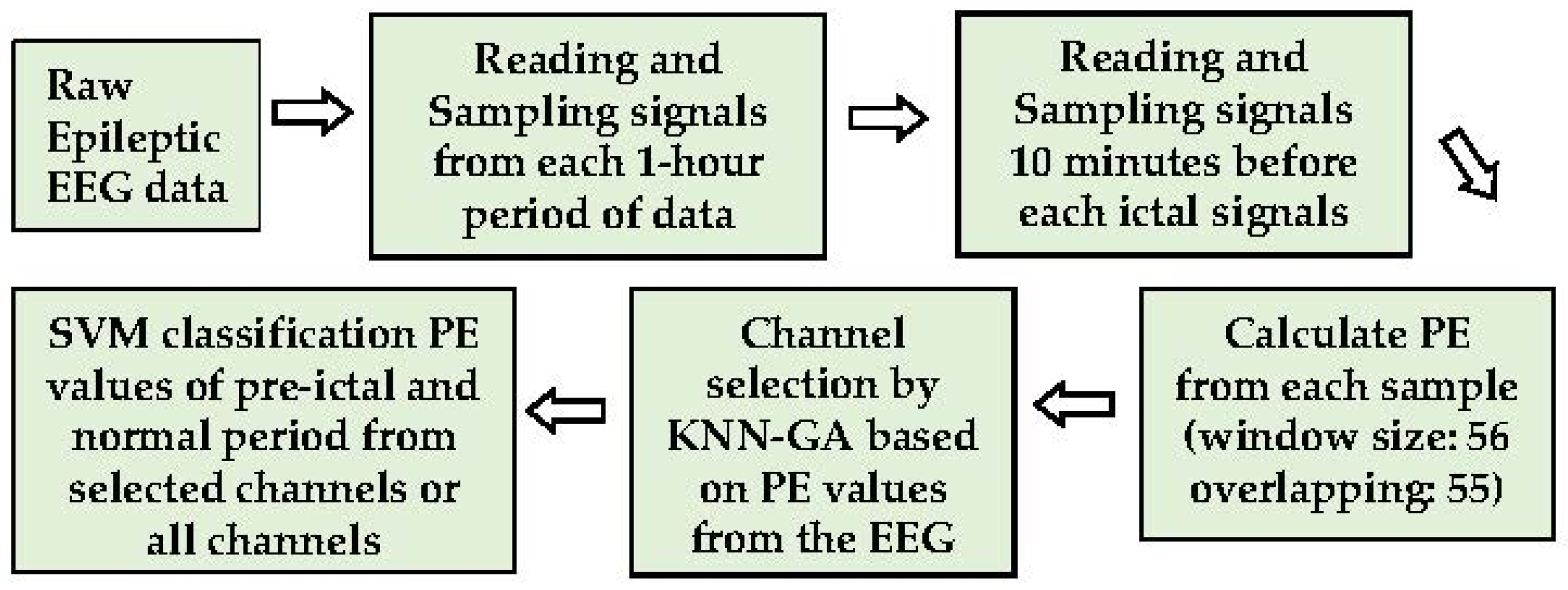
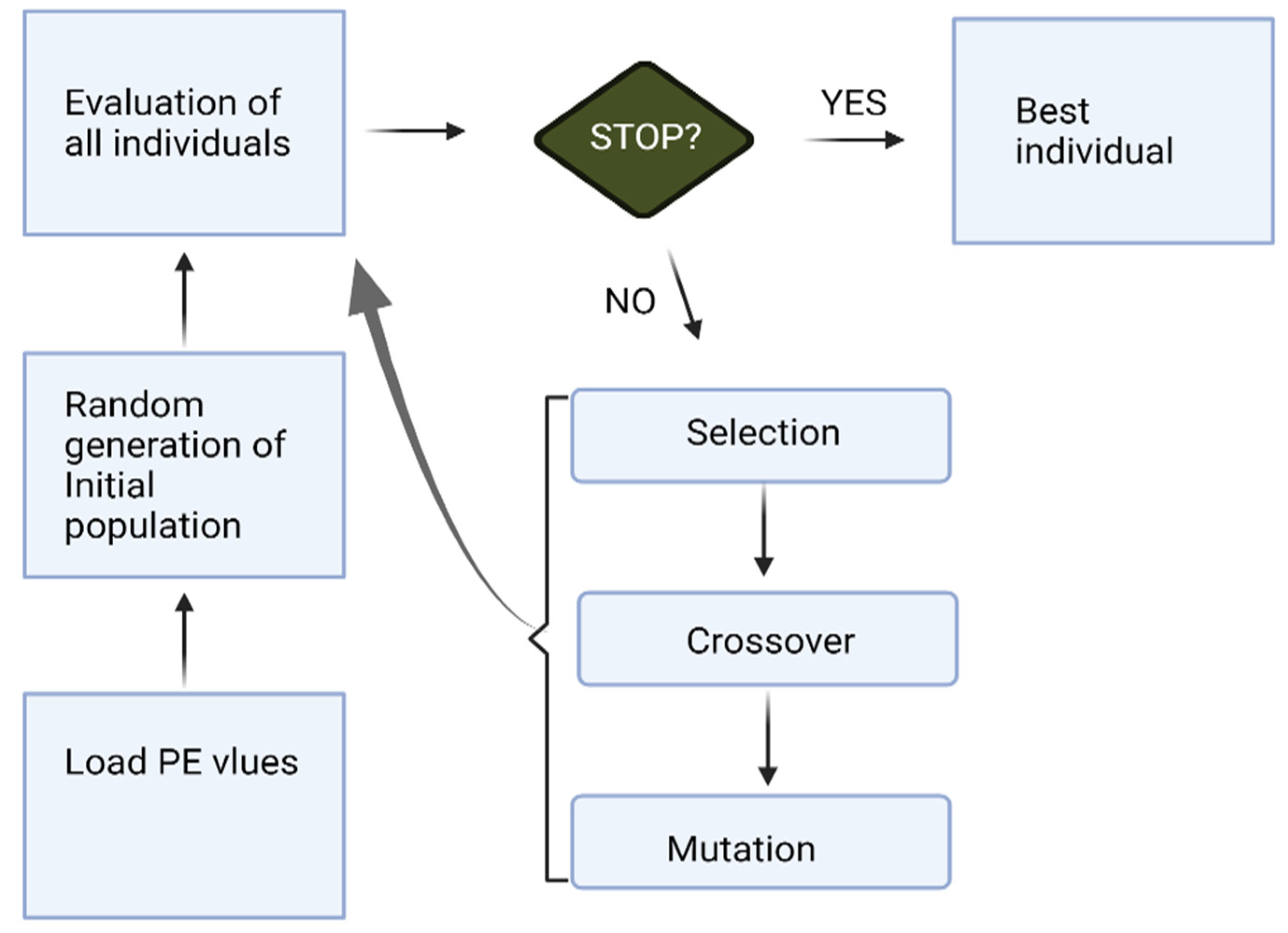
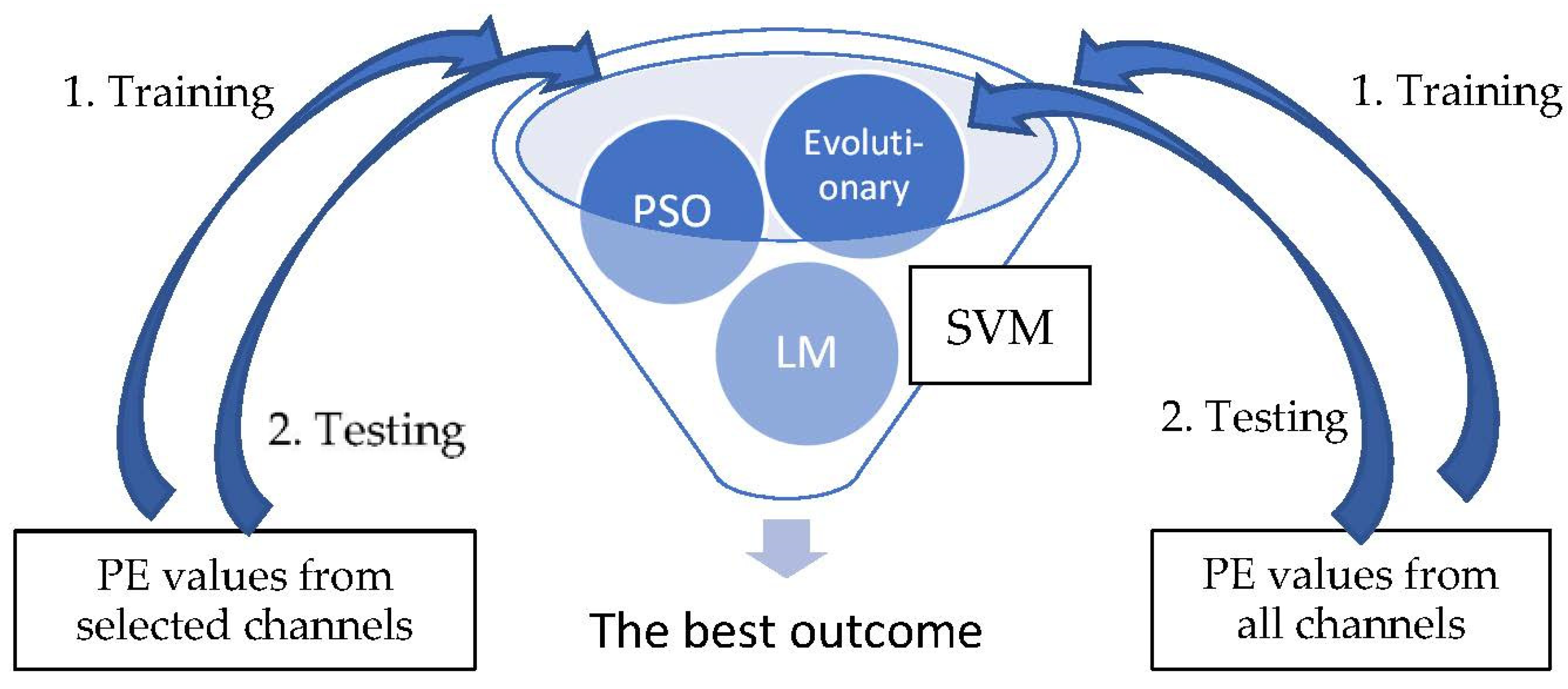


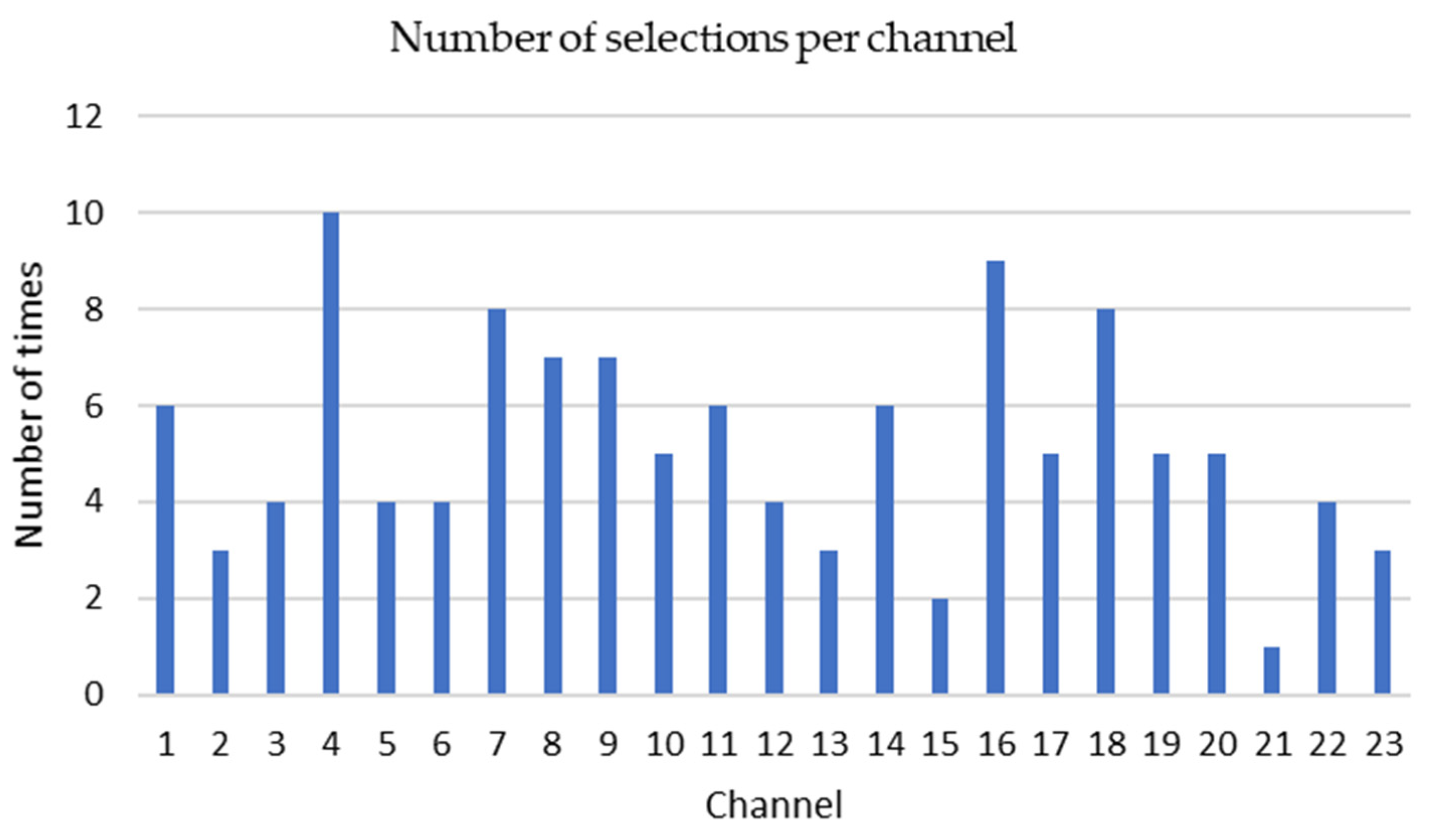
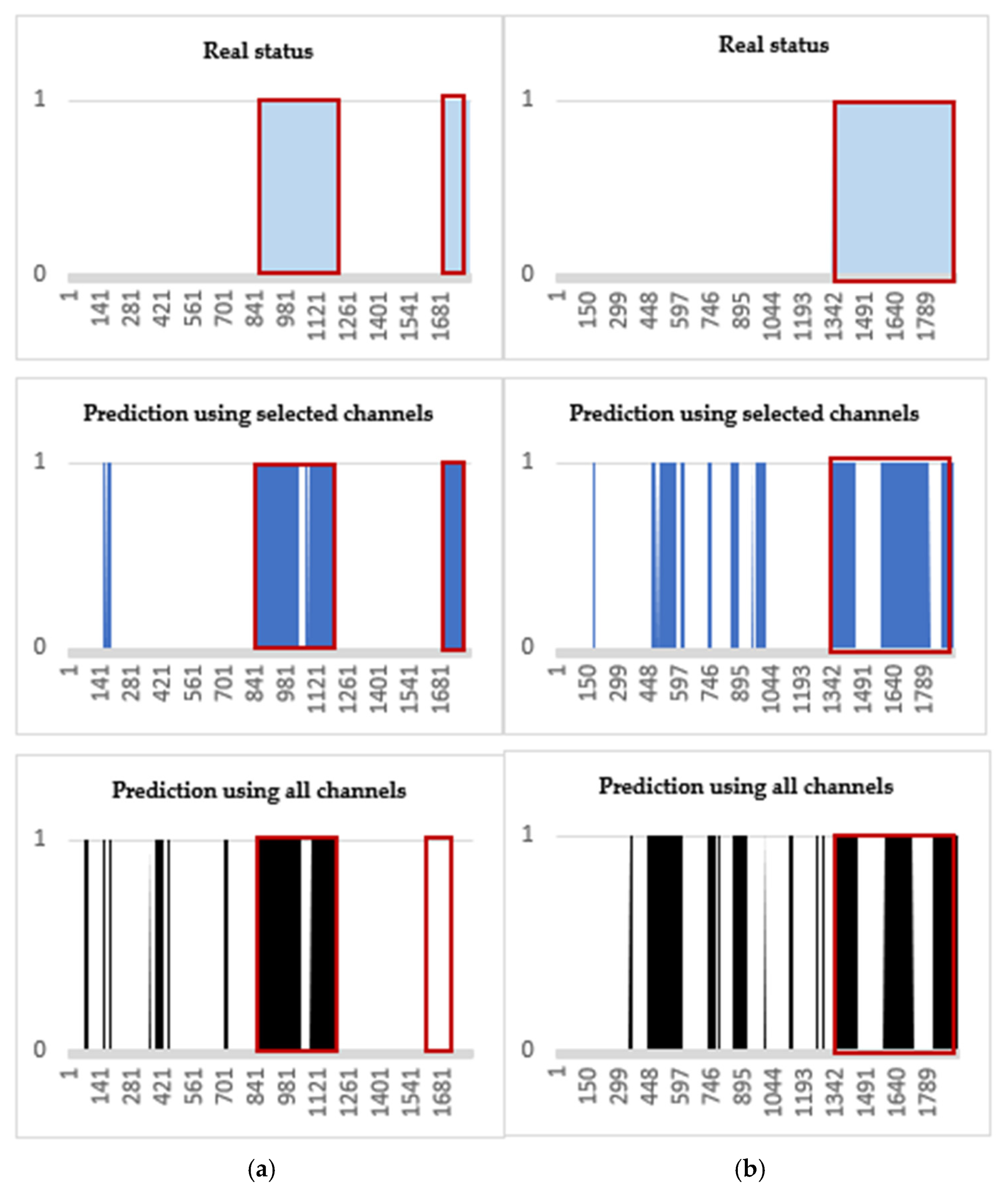
| Patient ID | Gender | Age | Number of Seizures | Length of Records (Hours) |
|---|---|---|---|---|
| 1 | F | 11 | 7 | 45.00 |
| 2 | M | 11 | 3 | 39.57 |
| 3 | F | 14 | 7 | 57.87 |
| 4 | M | 22 | 4 | 154.41 |
| 5 | F | 7 | 5 | 38.09 |
| 6 | F | 1.5 | 10 | 89.25 |
| 7 | F | 14.5 | 3 | 67.23 |
| 8 | M | 3.5 | 5 | 26.38 |
| 9 | F | 10 | 4 | 65.92 |
| 10 | M | 3 | 7 | 72.49 |
| 11 | F | 12 | 3 | 73.30 |
| 12 | F | 2 | 40 | NA |
| 13 | F | 3 | 12 | NA |
| 14 | F | 9 | 8 | 41.50 |
| 15 | M | 16 | 20 | 62.29 |
| 16 | F | 7 | 10 | 17.03 |
| 17 | F | 12 | 3 | 34.11 |
| 18 | F | 18 | 6 | 62.85 |
| 19 | F | 19 | 3 | 61.58 |
| 20 | F | 6 | 8 | 41.43 |
| 21 | F | 13 | 4 | 55.71 |
| 22 | F | 9 | 3 | 75.93 |
| 23 | F | 6 | 7 | 70.90 |
| 24 | NA 1 | NA | 16 | NA |
| True Pre-Ictal Period | True Normal Period | |
|---|---|---|
| Predict pre-ictal period | I | II |
| Predict normal period | III | IV |
| Patient ID | Recording Duration (Hours) | Number of Seizures | Selected Channels 1 | Test Results (Selected Channels/All Channels) 2 | Execution Time s: Second(s) ms: Milli-Second(s) | SVM Optimization Methods | ||||
|---|---|---|---|---|---|---|---|---|---|---|
| Train | Test | Prediction Rate (%) | Accuracy (%) | Sensitivity (%) | Specificity (%) | |||||
| 1 | 45.00 | 4 | 3 | 4, 11, 16, 18 | 100/100 | 97.28/100 | 93.66/100 | 100/100 | 32 ms (30% 4)/46 ms | LM |
| 2 | 39.57 | 1 | 2 | 5, 6, 8, 11 | 100/75 | 54.27/30.85 | 50.00/38.02 | 56.40/27.27 | 47 ms (40%)/78 ms | Evolutionary |
| 3 | 57.87 | 4 | 3 | 4, 8, 14, 16, 18, 19, 20, 23 | 100/67 | 77.89/70.51 | 70.91/62.81 | 81.07/74.00 | 121 s (24%)/159 s | Evolutionary |
| 4 | 154.41 | 2 | 2 | 8, 10, 14, 17, 18, 19 | 100/50 | 80.79/76.82 | 45.45/24.79 | 84.71/82.60 | 44 s (15%)/52 s | PSO |
| 5 | 38.09 | 2 | 3 | 1, 7, 9, 13, 16 | 100/50 | 58.19/55.19 | 90.12/46.88 | 38.65/60.27 | 1 s (80%)/5 s | Evolutionary |
| 6 | 89.25 | 6 | 4 | 6, 9, 14, 16, 18 | 100/75 | 66.04/58.38 | 71.19/59.27 | 57.02/56.82 | 250 ms (33%)/375 ms | LM |
| 7 | 67.23 | 1 | 2 | 4, 11, 16, 18 | 100/50 | 83.61/80.17 | 99.17/0.00 | 80.50/96.20 | 16 ms (48%)/31 ms | LM |
| 8 | 26.38 | 2 | 3 | 8, 14, 17, 19 | 100/100 | 95.73/65.56 | 87.19/74.38 | 100/62.40 | 16 ms (48%)/31 ms | LM |
| 9 | 65.92 | 3 | 1 | 4, 11, 16, 18, 20 | 100/100 | 69.01/61.98 | 34.71/68.60 | 72.82/61.25 | 31 ms (83%)/187 ms | LM |
| 10 | 72.49 | 3 | 4 | 4, 8, 11, 16, 18, 20 | 75/75 | 65.97/44.03 | 80.17/74.10 | 60.64/61.98 | 17 s (29%)/24 s | PSO |
| 11 | 73.30 | 1 | 1 | 3, 4, 7, 8, 10, 17, 21 | 100/0 | 84.55/71.98 | 50.41/0.00 | 88.34/47.70 | 16 ms (36%)/47 ms | LM |
| 12 | NA 3 | NA | NA | NA | NA | NA | NA | NA | NA | NA |
| 13 | NA 3 | NA | NA | NA | NA | NA | NA | NA | NA | NA |
| 14 | 41.50 | 5 | 3 | 1, 2, 3, 5, 7, 9, 23 | 33.3/33.3 | 61.67/60.27 | 32.51/18.73 | 70.41/72.73 | 64 s (11%)/72 s | Evolutionary |
| 15 | 62.29 | 6 | 7 | 1, 7, 17, 10, 16, 22, CP2-Ref | 100/42.9 | 75.48/63.87 | 69.42/22.41 | 80.33/97.02 | 1 s (80%)/5 s | LM |
| 16 | 17.03 | 2 | 3 | 1, 2, 5, 7, 9, 10, 15, 16 | 100/100 | 69.97/69.83 | 100/100 | 54.96/54.75 | 93 ms (69%)/297 ms | LM |
| 17 | 34.11 | 2 | 1 | 1, 9, 12 | 100/100 | 45.45/46.38 | 100/87.60 | 37.66/40.50 | 31 ms (34%)/47 ms | LM |
| 18 | 62.85 | 2 | 4 | 4, 7, 13, 20, 22 | 75/75 | 71.63/66.39 | 42.77/50.00 | 86.05/74.59 | 15 s (6%)/16 s | PSO |
| 19 | 61.58 | 1 | 1 | 4, 6, 14 | 100/100 | 94.86/96.05 | 90.08/100 | 95.45/95.56 | 16 ms (57%)/37 ms | LM |
| 20 | 41.43 | 4 | 4 | 3, 4, 6, 7, 12, 15 | 100/75 | 94.63/87.02 | 90.63/88.43 | 96.34/86.42 | 20 s (9%)/22 s | PSO |
| 21 | 55.71 | 2 | 2 | 4, 7, 13, 19, 20, 22 | 50/50 | 69.35/49.44 | 42.15/23.14 | 75.39/55.28 | 297 ms (62%)/781 ms | LM |
| 22 | 75.93 | 2 | 1 | 1, 2, 9, 12, 23 | 100/100 | 88.55/80.05 | 24.79/22.31 | 99.17/89.67 | 16 ms (48%)/31 ms | LM |
| 23 | 70.90 | 4 | 3 | 8, 10, 14, 17, 18, 19 | 100/100 | 87.40/100 | 96.69/100 | 59.50/100 | 15 ms (6%)/16 ms | LM |
| 24 | NA | 10 | 5 | 3, 5, 9, 11, 12, 23 | 80/80 | 48.91/49.44 | 67.27/76.03 | 33.61/27.27 | 312 ms (38%)/500 ms | LM |
| Accuracy | Sensitivity | Specificity | ||||
|---|---|---|---|---|---|---|
| Selected Channels | All Channels | Selected Channels | All Channels | Selected Channels | All Channels | |
| N | 22 | 22 | 22 | 22 | 22 | 22 |
| ∑X | 1641.23 | 1484.21 | 1529.29 | 1237.50 | 1609.02 | 1524.28 |
| Mean | 74.60 | 67.46 | 69.51 | 56.25 | 73.14 | 69.29 |
| σ | 15.36 | 18.36 | 25.03 | 33.44 | 20.81 | 22.52 |
| p-value | 0.002699 | 0.033532 | 0.339937 | |||
| F-ratio | 11.5588 | 5.17403 | 0.95353 | |||
| significant at α = 0.01 | significant at α = 0.05 | not significant at α = 0.05 | ||||
Publisher’s Note: MDPI stays neutral with regard to jurisdictional claims in published maps and institutional affiliations. |
© 2021 by the authors. Licensee MDPI, Basel, Switzerland. This article is an open access article distributed under the terms and conditions of the Creative Commons Attribution (CC BY) license (https://creativecommons.org/licenses/by/4.0/).
Share and Cite
Ra, J.S.; Li, T.; Li, Y. A Novel Permutation Entropy-Based EEG Channel Selection for Improving Epileptic Seizure Prediction. Sensors 2021, 21, 7972. https://doi.org/10.3390/s21237972
Ra JS, Li T, Li Y. A Novel Permutation Entropy-Based EEG Channel Selection for Improving Epileptic Seizure Prediction. Sensors. 2021; 21(23):7972. https://doi.org/10.3390/s21237972
Chicago/Turabian StyleRa, Jee S., Tianning Li, and Yan Li. 2021. "A Novel Permutation Entropy-Based EEG Channel Selection for Improving Epileptic Seizure Prediction" Sensors 21, no. 23: 7972. https://doi.org/10.3390/s21237972
APA StyleRa, J. S., Li, T., & Li, Y. (2021). A Novel Permutation Entropy-Based EEG Channel Selection for Improving Epileptic Seizure Prediction. Sensors, 21(23), 7972. https://doi.org/10.3390/s21237972






